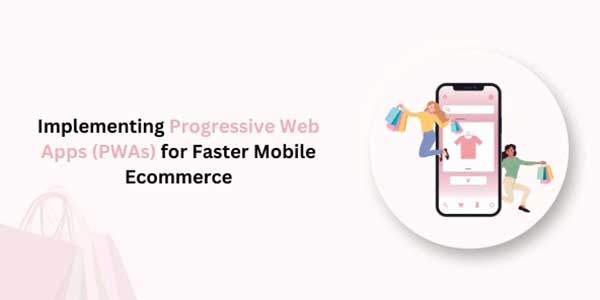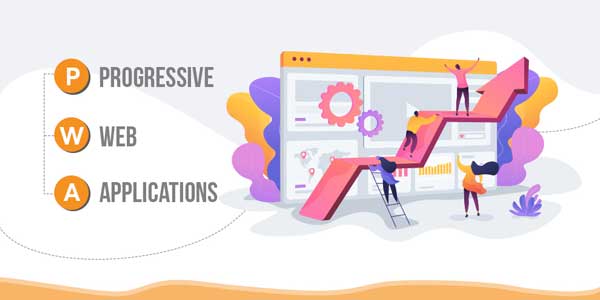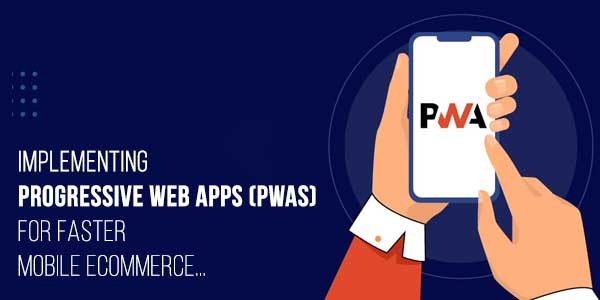
PWAs are like advanced websites that act like apps on your phone. They work without the internet, load quickly, send you notifications, and you can add them to your home screen. With more people shopping on their phones, stores need to make sure their websites are easy and fun to use. Slow websites can annoy customers, and people are tired of downloading too many apps.
Progressive web apps (PWAs) are like supercharged websites that work well on your phone. They load quickly and feel like the apps you download, but you use them through a browser. This is great for people shopping on their phones because everything works smoothly and fast, making buying stuff easier. For businesses, this means happier visitors who stick around longer and buy more. PWAs are a big deal because they make shopping on your phone better without the hassle of downloading an app. They help shops sell more by making the shopping experience cool and easy.
Table of Contents
What PWAs Offer For Mobile eCommerce?
Progressive web apps provide transformative benefits for e-commerce businesses seeking to enhance their mobile shopping experiences. By utilizing modern web capabilities like service workers and web manifests, PWAs deliver app-style performance, push notifications, and seamless user experiences directly in the browser. The end result is mobile shopping that is faster, more engaging, and easier than ever before.
A.) Performance Boost:
PWAs achieve massive speed improvements through the use of service workers and intelligent caching mechanisms. Service workers are scripts that allow web apps to store files locally on a user’s device for instant loading on return visits. Resources like images, CSS, JavaScript, and even page content are cached locally, so they load straight from the cache instead of requiring time-intensive network requests.
This means that on second visits, pages that previously took 10+ seconds to load over mobile networks now pop up instantly. By one estimate, PWAs load anywhere from 3-10x faster than equivalent mobile web pages. For example, e-commerce provider BigCommerce saw time to interact reduce from 12+ seconds to just 3 seconds after migrating their mobile experience to a PWA.
Speed is hugely impactful for mobile commerce sites. Research shows that 47% of users expect pages to load in 2 seconds or less before abandoning a site. Yet the average mobile page takes 15+ seconds to load fully. This speed gap leads many users to bounce from sites before they even engage.
Metrics prove that with PWA speeds, retailers can rescue many of these lost customers and increase conversions:
- Each additional 1-second delay reduces conversions by 7%. A 5-second delay tanks conversions by a catastrophic 90%.
- However, sites that load in under 2 seconds benefit from more page views and the conversion rate increases up to 400%.
By boosting performance with PWAs, retailers can provide the effortless, stutter-free experience mobile users have come to expect thanks to apps. Friction is reduced, engagement rises, and conversions follow.
B.) Enhanced User Experience:
In addition to faster speeds, PWAs enhance the user experience by incorporating app-quality features, seamless offline use, and engaging interfaces:
App-like capabilities:
- Push notifications drive re-engagement by proactively alerting users to relevant content updates.
- Home screen icons and splash screens make PWAs feel like standalone apps while avoiding app store hurdles.
- Smooth transitions between pages keep users focused on shopping instead of waiting.
Offline accessibility:
- Previously cached content loads instantly when offline thanks to service workers.
- While offline, the basic structure of the site remains functional so users can still navigate and browse.
- This prevents frustration when mobile connections are spotty.
Immersive interfaces:
- PWAs facilitate scrolling feeds, expansive galleries, and full-screen media more suited to mobile devices than desktop-oriented sites.
- Capabilities like camera/microphone access, geolocation, and device sensors enable engaging new features.
- Transitions, gestures like swipe menus, and effects like parallax scrolling provide a native-app look and feel.
- Retail sites can also leverage payment handlers for one-tap checkout.
By blending web versatility, app capabilities, and integrated offline use, PWAs remove much of the friction users expect from mobile shopping. The experience feels familiar yet fast, engaging yet dependable.
C.) Increased Reach And Accessibility:
By removing app store barriers, accelerating performance, and minimizing device requirements, progressive web apps reach more users and expand access to mobile commerce:
No download or installation friction:
- PWAs work instantly without App Store approval delays or download/storage requirements.
- Impulse shoppers can immediately access the site regardless of app fatigue.
Low bandwidth optimization
- Caching and service workers enable PWAs to work well even in emerging markets with limited connectivity.
- Older devices with less processing power also benefit greatly from performance optimizations.
Enhanced discoverability
- PWAs get indexed by search engines, enabling shoppers to easily discover retail sites through mobile web searches.
- App store searches tend to favor major brands, but PWAs appear in broad web searches.
By streamlining access for both new and returning visitors, PWAs widen the addressable mobile market. With smoother entry points and performance-tuned for all device types, retailers can reduce barriers that may exclude potential shoppers. The result is a more accessible and frictionless mobile commerce ecosystem.

How To Implement A PWA For Your eCommerce Site?
Successfully implementing a progressive web app requires thoughtful planning, technical integration, and ongoing optimization after launch. By following best practices, e-commerce businesses can craft fast, engaging PWA experiences.
A.) Planning And Analysis:
Carefully planning and analyzing your existing site is crucial for PWA success:
Identify Goals And Target Users:
- Define your target audience(s) for the PWA and understand their needs through user research.
- Establish clear business goals and success metrics like conversion rates, average order value, and user engagement.
Audit Existing Site:
- Gather performance data on current mobile websites using web vitals and analytics.
- Identify UX weaknesses, technical bottlenecks, and opportunities to optimize.
- Establish an analytics and user feedback baseline to compare after the PWA launch.
Choose Implementation Tools:
- Research PWA build tools like Workbox.js, PWA plugins for CMS platforms, and JavaScript frameworks with PWA components.
- Select technologies that integrate well with your existing architecture and developer skill sets.
- Prioritize flexible, future-proof solutions as capabilities expand.
Conducting rigorous planning and analysis provides a focused roadmap for implementation while revealing steps needed to maximize benefits. It sets the stage for delivering fast performance and delighting mobile users
B.) Development And Implementation:
With planning finished, PWA development and implementation involves key technical considerations:
Core Technical Elements:
- Service workers act as proxy servers to enable features like push notifications, background syncing, and caching.
- The web app manifest is a JSON file that specifies how the PWA should behave when installed on a device.
- HTTPS encryption is a requirement for utilizing service workers.
Approaches:
- Build a PWA from scratch using frameworks like React and Vue.js.
- Convert an existing site using tools like Workbox.js or PWA plugins for popular CMS platforms like WordPress and Magento.
Best Practices:
- Performance optimizes images, scripts, and fonts and enables compression.
- Follow accessibility guidelines for color contrast, screen reader capability, etc.
- Implement offline gauges and messaging to manage expectations.
- Validate with Lighthouse to check all required components work.
Testing And Deployment:
Before launching a PWA, rigorous testing and thoughtful go-to-market planning are critical:
Testing:
- Test extensively on various devices (low/high-end phones, tablets, laptops) and browsers to uncover bugs.
- Examine usability and analyze performance metrics compared to planning goals using analytics and aggregated user feedback.
- Refactor and enhance based on test findings before public deployment.
Launch Planning:
- Increase visibility by submitting the PWA to app catalogs/stores for discovery.
- Message the benefits prominently on-site and actively notify users to inspire upgrades.
- Analyze adoption rates, user sentiment, and business metrics vs. KPIs defined earlier to continually refine after deployment.
By thoroughly testing PWAs and strategically highlighting their advantages at launch, retailers can maximize adoption and ROI while identifying areas for improvement. Continued monitoring after deployment enables issues to be rapidly addressed and capabilities expanded based on real user data.
Challenges And Considerations:
Implementing progressive web apps can deliver tremendous benefits, but retailers should also be aware of potential challenges and considerations:
Technical Challenges
- Requires migration of legacy systems not built for PWA features like service workers and manifests.
- PWAs may not work fully as intended on older browsers lacking full support for modern web standards.
- App-like animations and transitions can increase development complexity.
- Push notification setup requires integration with third-party services.
- Offline functionality needs comprehensive testing across many scenarios.
- Access to native device hardware like camera and GPS can be limited in some browsers.
Resource Challenges
- Requires experienced web developers familiar with PWA technologies.
- Ongoing performance tuning and optimization are needed as capabilities expand.
- May require additional server capacity to handle features like caching and push notifications.
- Marketing and user education efforts are needed to highlight benefits and encourage upgrades.
Compatibility Considerations
- PWA capabilities vary across iOS and Android devices and OS versions.
- Functionality differences exist between mobile, desktop and tablet browsers.
- Fallbacks must be implemented for browsers with limited service worker support.
- Not all users may consent to enable push notification permissions.
Need For Maintenance
- Requires ongoing monitoring of web vitals and performance metrics.
- Regular testing is needed across devices and OS versions as they are updated.
- Must implement progressive enhancement as new APIs and features emerge.
- Periodic UX analysis and enhancements are necessary based on user feedback.
Conclusion:
Progressive web apps deliver app speed and engagement directly through the browser. Implementing PWAs can transform mobile commerce for retailers by driving loyalty, reach, and sales. However, achieving success requires rigorous planning, development, and optimization. While challenging, PWAs represent a critical mobile investment – satisfying customer demands for fast, flexible shopping experiences. Retailers that leverage PWAs distinguish themselves competitively while future-proofing their presence.
Frequently Asked Questions:
Q: How much development work is PWA conversion?
A: Depends on site complexity, but can range from weeks to months. Requires adding service workers, manifest, optimizations, etc.
Q: What are the main PWA technical requirements?
A: HTTPS, service worker registration, web manifest, load fast, and work offline using caching.
Q: How do you get users to upgrade to the PWA?
A: Message benefits on-site, email campaigns, social media. Auto-prompt on the first visit helps adoption. Monitor analytics.

 About the Author:
About the Author:
















Be the first to write a comment.